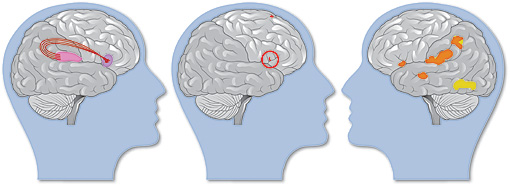You are here
20101220-dyslexia.jpg

Media Folder
Title
Brains compensating for dyslexia vs. brain of a typical reader
Caption
Brains of adolescents who compensated for dyslexia had strong connections on the right side of the brain. When involved in rhyming tasks, the brains of youth who compensated for dyslexia showed increased activity in a brain area known as the inferior frontal gyrus. In contrast, brains of typically developing readers show increased activity on the left side of the brain when involved in rhyming.
Description
(Left) Brains of adolescents who compensated for dyslexia had strong connections on the right side of the brain, between a brain area that processes images and an area that stores images in long term memory. When involved in rhyming tasks, the brains of youth who compensated for dyslexia showed increased activity in a brain area known as the inferior frontal gyrus (center). In contrast, (right) brains of typically developing readers show increased activity on the left side of the brain when involved in rhyming.
Site_Section
Alt Text
Brains compensating for dyslexia vs. brain of a typical reader
